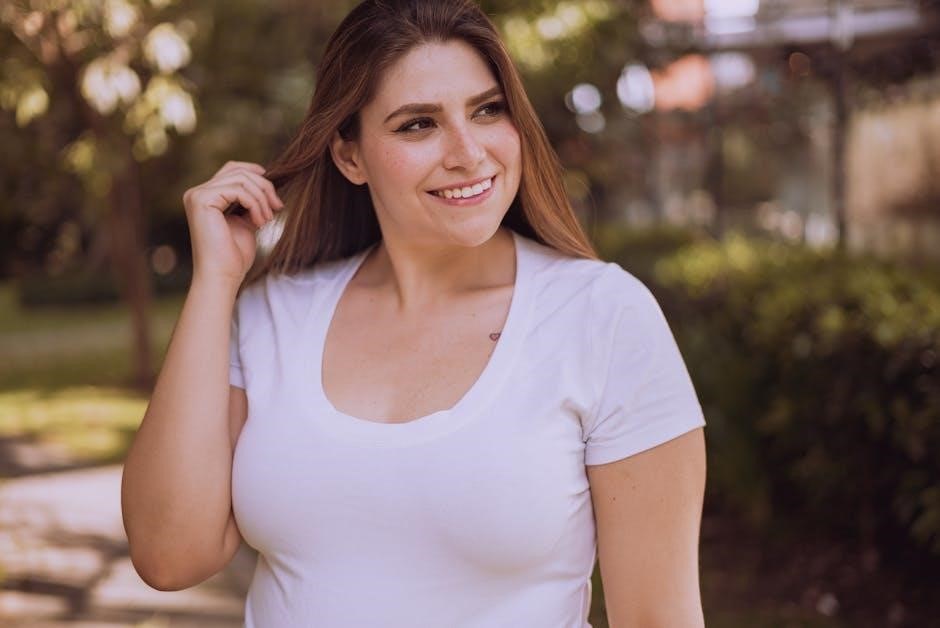
Discover the ultimate guide to finding your perfect fit with our comprehensive women’s t-shirt size guide. Learn about sizing variations, styles, and tips for a flattering, comfortable fit.
Understanding the Importance of Proper Fit
A proper fit is essential for both comfort and confidence. Ill-fitting clothes can cause discomfort and affect your posture. Women’s t-shirt size guides help ensure the garment drapes well, allowing freedom of movement. A good fit enhances your silhouette, boosting self-esteem. Poor fit can lead to returns or alterations, wasting time and money. Understanding measurements and styles ensures you choose a size that flatters your body type, whether petite, tall, or plus-size. Accurate sizing also prevents issues like restrictive fabric or excessive looseness, ensuring a polished look.
Overview of T-Shirt Styles and Sizes
Women’s t-shirts come in a variety of styles, including crew neck, V-neck, scoop neck, and more. Sizes typically range from XS to 3XL, with some brands offering plus-size options. Each style flatters different body types, such as petite, tall, or hourglass figures. Understanding the differences in cuts, like relaxed, fitted, or oversized, helps in choosing the right fit. Additionally, size charts vary by brand, so comparing measurements is key. This guide provides a clear breakdown of styles and sizes to help you navigate the options confidently and make informed choices for your wardrobe needs.

Standard Women’s T-Shirt Size Charts
Standard women’s t-shirt size charts typically range from XS to 3XL, providing measurements for chest, waist, and hip to help determine the best fit for comfort and style.
XS to 3XL Size Measurements
Women’s t-shirt sizes range from XS to 3XL, with each size corresponding to specific chest, waist, and hip measurements. XS typically fits a chest size of 28-30 inches, while 3XL accommodates up to 50-52 inches. These measurements ensure a comfortable fit, catering to diverse body types. The size chart provides a clear guide to selecting the right size based on individual measurements, ensuring optimal comfort and style.
How to Read a Size Chart
Reading a size chart for women’s t-shirts involves matching your measurements to the corresponding sizes. The chart typically includes chest, waist, and hip measurements for each size range (XS to 3XL). Locate your measurements on the chart and align them with the closest size. Pay attention to whether the measurements are in inches or centimeters. Accurate measurements ensure the best fit. Note that size charts may vary slightly between brands, so always refer to the specific chart provided for the most accurate sizing.

Plus-Size T-Shirt Size Guide
Explore our detailed guide for plus-size women’s t-shirts, offering extended sizes and tailored fits. Learn how to choose styles that flatter your figure and ensure comfort.
Extended Sizes for Women
Extended sizes for women ensure inclusivity and comfort. Our guide offers detailed measurements for plus-size ranges, from 1X to 6X. Finding the right fit is essential, and our charts provide accurate chest, waist, and hip measurements. Fabrics play a crucial role in comfort, with stretchy materials offering flexibility. To ensure the best fit, measure yourself regularly and refer to our size chart. Proper fit enhances confidence, and our guide helps you achieve it effortlessly. Explore styles that flatter your figure and prioritize comfort without compromising on fashion.
Fit Differences in Plus Sizes
Plus-size T-shirts often feature tailored cuts for a balanced silhouette. Fabric choice impacts comfort, with stretchy materials offering better flexibility. Designs may include darts or shaping to enhance fit. Measure your chest, waist, and hips for accuracy, as sizes can vary between brands. Relaxed fits provide comfort, while fitted styles accentuate curves. Ensure the shoulder seams align with your natural shoulder line for the best look. Proper fit boosts confidence, so choose styles that complement your body type and personal style.

Understanding Different Fits
Explore various T-shirt fits, from classic and slim to oversized and tailored, each offering unique comfort and style to suit different body types and personal preferences.
Classic Fit vs. Slim Fit
A classic fit T-shirt offers a relaxed, comfortable silhouette with a looser cut through the chest and waist, making it suitable for most body types. In contrast, a slim fit T-shirt is tailored closer to the body, providing a modern, form-fitting look. The classic fit is ideal for casual wear, while the slim fit is perfect for those seeking a more stylish, contemporary appearance. Fabric choice also plays a role, as stretchy materials enhance the slim fit’s comfort while maintaining its sleek design.
Oversized Fit vs. Tailored Fit
An oversized fit T-shirt offers a loose, relaxed silhouette with a boxy shape, often extending below the hips for a casual, trendy look. In contrast, a tailored fit is designed to skim the body, creating a more polished, structured appearance. The oversized fit is ideal for layering or achieving a streetwear aesthetic, while the tailored fit complements curves and is perfect for styling with skirts or trousers. Both styles cater to different fashion preferences and body types, ensuring a flattering look for various occasions.
Relaxed Fit vs. Fitted Fit
A relaxed fit T-shirt offers a loose, comfortable silhouette with a slightly longer length and a casual vibe, making it ideal for everyday wear or layering. In contrast, a fitted fit hugs the body, accentuating curves for a more polished look. Relaxed fits are perfect for those who prioritize comfort and a laid-back style, while fitted fits are great for showcasing personal shape and pairing with structured pieces. Both options cater to different preferences, offering versatility for various lifestyles and fashion goals.

How to Measure Yourself for the Best Fit
Use a flexible tape measure to measure around your bust, natural waist, and hips. Ensure the tape is level and not too tight for accurate sizing.
Measuring Your Chest
To measure your chest accurately, wrap a flexible tape measure around the fullest part of your bust, keeping it level and parallel to the floor. Stand up straight with your arms down for the most precise reading. The tape should not be too tight or too loose, as this can affect the sizing. For the best results, wear a well-fitting bra and avoid measuring over bulky clothing. This measurement is essential for determining your t-shirt size and ensuring a comfortable, flattering fit.
Measuring Your Waist
To measure your waist, locate the narrowest point above your hips and below your ribcage. Wrap a flexible tape measure around this area, keeping it level and parallel to the floor. Stand up straight with your arms relaxed for an accurate reading. The tape should be snug but not tight, providing a comfortable fit. This measurement helps determine your t-shirt size and ensures the garment sits properly. For the most accurate result, wear a fitted shirt or bra and avoid measuring over bulky clothing;
Measuring Your Hip
To measure your hip, stand straight and locate the widest part of your hips, typically 7-9 inches below your waistline. Wrap a flexible tape measure around this area, ensuring it is level and parallel to the floor. The tape should be snug but not tight. This measurement helps determine your t-shirt size and ensures the garment fits comfortably around your hips. Keep your arms relaxed and avoid pulling the tape too tight or holding it too loose. For accuracy, wear tight-fitting clothing or no clothing, as loose fabrics may distort the measurement.

Fabric and Fit Relationship
Fabric type significantly impacts fit. Natural fibers like cotton offer softness and drape, while synthetic or blended fabrics provide structure and stretch, ensuring comfort and shape retention.
How Fabric Type Affects Fit
Fabric type plays a crucial role in how a T-shirt fits. Natural fibers, like cotton, offer breathability and a soft drape, while synthetic fabrics, such as polyester, provide stretch and structure. Blends combine the benefits of both, offering comfort and durability. Thicker fabrics may create a more structured fit, whereas lightweight materials drape loosely, enhancing comfort. Understanding fabric composition helps determine how the T-shirt will mold to your body, ensuring a flattering and comfortable fit. Choose fabrics that align with your lifestyle and desired feel for the best results.
Stretchy Fabrics vs. Non-Stretchy Fabrics
Stretchy fabrics, like spandex or elastane blends, offer flexibility and a snug fit, making them ideal for active lifestyles. They hug the body, providing comfort and movement. In contrast, non-stretchy fabrics, such as pure cotton or linen, prioritize breathability over flexibility. These fabrics create a more relaxed, structured fit and are perfect for casual wear. Choosing between stretchy and non-stretchy fabrics depends on your activity level and desired comfort. Stretchy fabrics mold to your body, while non-stretchy ones maintain their shape, ensuring a comfortable and flattering fit for any occasion.
Common Fit Issues and Solutions
Common fit issues like shirts being too tight or loose can be resolved by ensuring accurate measurements and selecting styles that complement your body type for optimal comfort.
Too Tight or Too Loose: Finding the Balance
Finding the perfect fit between too tight and too loose is essential for comfort and style. A shirt that’s too tight may restrict movement, while one that’s too loose can lack shape. Measure accurately to ensure the best fit, and consider the fabric’s stretch. For example, stretchy fabrics like cotton-poly blends offer flexibility, while non-stretch fabrics like linen require precise sizing. Use size charts and reviews to guide your choice, ensuring the shirt skims your body without being restrictive or boxy for a flattering, comfortable look.
Addressing Shoulder, Bust, and Waist Fit
Ensuring a flattering fit across the shoulders, bust, and waist is crucial for comfort and style. The shoulders should sit smoothly without slipping or digging, while the bust should fit comfortably, avoiding tightness or gapping. For the waist, the shirt should neither be too restrictive nor too loose. Use size charts to align these measurements and consider fabric stretch for flexibility. For example, V-necks can elongate the torso, while A-line styles skim the waist. Proper fit in these areas ensures a balanced, polished look tailored to your body type.

Comparing Fits Across Brands
Women’s T-shirt sizes vary across brands due to differences in patterns, fabrics, and cuts. Always check the specific size chart for each brand to ensure the best fit.
Why Sizes Vary Between Brands
Women’s T-shirt sizes differ across brands due to varying measurement standards, fabric types, and fit styles. Some brands use generic sizing, while others cater to specific body types. Fabric stretch, stitching techniques, and design intent also influence fit. Additionally, brands may adjust sizing based on target demographics or regional preferences. This lack of a universal standard means that a size 8 in one brand may not match another. Always refer to individual brand size charts for accurate measurements to ensure the best fit for your body type and desired style.
Tips for Comparing Sizes
When comparing sizes across brands, always refer to individual size charts for accurate measurements. Use filters on e-commerce sites to narrow down fits by body type or style. Check customer reviews for insights into how a brand’s sizing runs. Consider the fabric type, as stretchy materials may fit differently than non-stretch fabrics. If possible, try on shirts from different brands to understand their fit nuances. Keep a list of brands that consistently fit well for future purchases. This approach ensures a more tailored and efficient shopping experience.

Styling Tips Based on Body Type
- Petite: Opt for fitted styles to elongate the torso and balance proportions.
- Tall: Choose oversized or longer-length shirts to create a balanced silhouette.
- Hourglass: Highlight curves with tailored fits that cinch at the waist.
- Pear-Shaped: Select A-line or flared styles to draw attention upward and balance hips.
Petite, Tall, Hourglass, and Pear-Shaped Body Types
Understanding your body type is key to selecting flattering T-shirts. For petite women, cropped or fitted styles elongate the torso. Tall individuals can opt for longer-length shirts to balance proportions. Hourglass figures look stunning in tailored fits that accentuate the waist, while pear-shaped body types benefit from A-line or flared designs to draw attention upward. Each style enhances unique features, ensuring a confident and polished look. Use these tips to choose T-shirts that complement your silhouette perfectly.
Choosing the Right Style for Your Body
Selecting the right T-shirt style for your body type ensures comfort and confidence. For petite frames, opt for cropped or fitted tees to elongate the torso. Tall women benefit from longer-length shirts that balance proportions. Hourglass figures shine in tailored fits that highlight the waist, while pear-shaped bodies look great in A-line or flared styles. Consider your body type when choosing necklines, sleeves, and lengths to create a balanced, flattering look. Use size charts to confirm measurements and ensure the perfect fit for your unique silhouette.
Tips for Online Shopping
When shopping online, use size charts to ensure accuracy. Read reviews for fit feedback and compare measurements across brands. Double-check your measurements before placing an order.
Using Size Charts Effectively
Using size charts effectively ensures a better fit when shopping online. Always compare your measurements to the chart provided for each product. Pay attention to specific styles, as fit can vary between classic, slim, and oversized options. Double-check the measurements for accuracy and consider the fabric type, as stretchy materials may offer more flexibility. By aligning your body measurements with the chart, you can reduce the risk of sizing errors and enjoy a more comfortable, flattering fit. This step is crucial for making informed purchases and avoiding returns.
Reading Reviews for Fit Feedback
Reading reviews for fit feedback is a valuable tool for ensuring the best fit. Customers often share insights into how a t-shirt fits, including comfort, fabric feel, and sizing accuracy. Pay attention to comments about whether the shirt runs true to size, feels tight, or is overly loose. Reviews can also highlight specific fit issues, such as shoulder or bust comfort. By analyzing feedback from others, especially those with similar body types, you can make more informed purchasing decisions and improve your chances of finding the perfect fit.

Trouser and Skirt Waist Size Relation
Trouser and skirt waist sizes closely relate to T-shirt fit. Your waist measurement is key for accurate sizing. Compare your waist size to the T-shirt size chart for the best fit.
How Waist Size Correlates to T-Shirt Fit
Your waist size plays a significant role in achieving the perfect T-shirt fit. It helps determine how the fabric will drape across your torso, ensuring comfort and style. For a relaxed fit, your waist size should align closely with the T-shirt’s waist measurement, while a fitted style may require a slightly smaller size. Accurate waist measurements are essential for avoiding a too-tight or too-loose fit. Use your waist size as a guide to select a T-shirt that complements your body type and personal style preferences.
Creating a Personalized Size Chart
Take accurate body measurements and compare them to standard size charts to create a customized fit guide tailored to your needs for comfort and style.
How to Make Your Own Size Guide
To create a personalized size guide, start by taking accurate body measurements, including chest, waist, and hips. Compare these measurements to standard size charts to identify your best fit. Consider factors like fabric stretch and desired fit style (e.g., slim, relaxed). Note any adjustments needed for specific body types or preferences. Use this data to build a custom chart tailored to your needs, ensuring comfort and style. Regularly update your guide as measurements change. This approach helps streamline shopping and ensures garments fit perfectly every time.

Seasonal Variations in Fit
Seasonal fabrics impact fit, with lightweight materials in summer offering a relaxed feel and thicker fabrics in winter providing structure. This affects comfort and style across seasons.
How Seasonal Fabrics Impact Fit
Seasonal fabrics significantly influence how a t-shirt fits and feels. Lightweight materials like cotton or linen in summer provide a breathable, relaxed fit, while thicker fabrics such as thermal or fleece in winter offer structure and warmth. The texture and weight of these fabrics can alter the drape and comfort, affecting the overall silhouette. Understanding these variations helps in choosing the right fabric for each season, ensuring both style and comfort remain consistent. This consideration is key for achieving the perfect fit year-round.
Mastering the women’s t-shirt size guide ensures a perfect fit and confident style. Always measure accurately, consider fabric, and choose styles that flatter your body type for ultimate comfort and elegance.
Key Takeaways for the Perfect Fit
Accurate measurements are essential for selecting the right size. Consider chest, waist, and hip measurements to ensure a comfortable and flattering fit. Fabric type impacts stretch and drape, so choose materials that suit your lifestyle. Classic, slim, or oversized fits cater to different body types, so experiment to find your preference. Refer to size charts and customer reviews for insights. Styling based on your body type enhances confidence and comfort. Always prioritize quality and fabric breathability for long-lasting wear. These tips ensure a tailored look and optimal comfort in every t-shirt.
Resources for Further Guidance
For additional support, explore official size charts from reputable brands and measurement guides tailored to women’s body types. Fabric care guides and styling tips can enhance your t-shirt experience. Visit fashion blogs or forums for real-life feedback and trend insights. Utilize online tools like size converters and virtual try-ons for personalized fits. Check out YouTube tutorials for measuring techniques and DIY alterations. These resources empower you to make informed decisions and maintain your wardrobe with confidence and style, ensuring a perfect fit every time.
Frequently Asked Questions
Why do sizes vary between brands? Sizing can differ due to unique measurements and fit standards. How do I measure myself accurately? Use a flexible tape measure and refer to the guide for proper techniques. What if I’m between sizes? Consider your preference for a snug or relaxed fit. How do I choose the right fabric? Select based on comfort, durability, and activity level. Can I return or exchange if the fit isn’t right? Check the brand’s return policy for specifics. These answers help ensure a seamless shopping experience and perfect fit for your t-shirt needs.